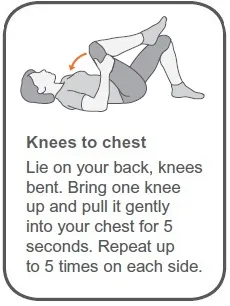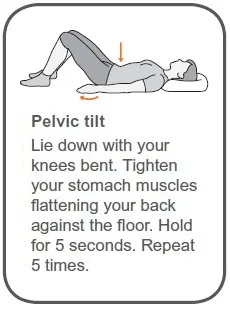David T. Turdy
What is back pain?
Back pain is a common problem which affects 4 out of 5 of us at some point. It’s often caused by a simple muscle, tendon or ligament strain and not usually by a serious problem.
Back pain can be acute, where the pain starts quickly but then reduces after a few days or weeks, or chronic, where pain might last on and off for several weeks or even months and years.
How is the back structured?
The spine, also called the backbone or spinal column, is one of the strongest parts of the body and gives us a great deal of flexibility and strength. It’s made up of 24 bones (vertebrae), one sitting on top of the other with discs in between and lots of strong ligaments and muscles around them for support.
On either side of the spine, running from top to bottom, are many small joints called the facet joints. The spinal cord passes inside the vertebrae, which protect it. Nerves pass through spaces between the bones of the spine to other parts of the body.
As you grow older, the structures of your spine, such as the joints, discs and ligaments, age as well. The structures remain strong but it’s usual for your back to get stiffer as you get older.

Back pain is often caused by a simple muscle, tendon or ligament strain and not usually by a serious problem.
Often back pain doesn’t have one simple cause but may be due to a range of factors, including:
- poor posture
- lack of exercise resulting in stiffening of the spine
- muscle strains or sprains.
As well as the factors listed above, there are also specific conditions which are associated with pain felt in the back.
Spondylosis
As we grow older the discs in the spine become thinner and the spaces between the vertebrae become narrower. Spurs of bone (osteophytes) may form at the edges of the vertebrae and facet joints. This is called spondylosis. All of us will have some of these changes in our spine as we get older, but they will not cause all of us pain.
Sciatica
Back pain is sometimes linked with pain in the legs, and there may be numbness or a tingling feeling. This is called sciatica. This is due to irritation or squeezing of one of the spinal nerves (called the sciatic nerve). For most people who develop sciatica, the leg pain tends to be the most troublesome symptom and they may not have back pain at all.
Pain travels down the leg because of the irritation of the sciatic nerve in the lumbar spine, but there’s actually nothing wrong with the leg itself. In most cases the reason for the nerve irritation is a bulging disc. Discs are designed to bulge but sometimes a bulge can ‘catch’ on the sciatic nerve roots causing pain that travels all down the leg to the foot.
Sciatica is fairly uncommon and fortunately most people recover fairly quickly, although in some cases it might take a number of months. About 60% of all people with sciatica get better within a few weeks to months.
Spinal stenosis
Spinal stenosis is back pain linked with pain in the legs which starts after a few minutes’ walking and tends to get better very quickly when you sit down. This can happen from birth or develop as we get older.
Symptoms often affect both legs but one may be worse than the other. The pain usually eases when you sit down and rest, and some people have less discomfort if they walk a little stooped. Like sciatica, the main problem tends to be leg pain more than back pain.
In most cases, neither sciatica nor spinal stenosis are causes for alarm, but if the symptoms cause you a lot of trouble and greatly affect your quality of life then you should see your doctor for further advice and to discuss what else can be done.
Other rarer causes of back pain include:
- bone problems such as a fracture – often linked to thinning of the bones (osteoporosis)
- an infection
- a tumour
- inflammation, such as in ankylosing spondylitis.
Treatments:
Painkillers
Simple painkillers such as paracetamol (an analgesic) may help. You should use them as and when you need them. It’s important that you take them regularly and at the recommended dose, especially when you’re having a flare-up of your back pain, but you shouldn’t take them more often than every 4 hours up to a maximum of eight tablets in 24 hours.
Non-steroidal anti-inflammatory drugs (NSAIDs)
NSAIDs such as ibuprofen, which you can buy at chemists and supermarkets, can also help.
You can use painkillers and NSAIDs for a short course of treatment of about a week to 10 days. If they’ve not helped after this time then they’re unlikely to. However, if they do help but the pain returns when you stop taking them you could try another short course.
You can also try rubbing anti-inflammatory creams or gels onto affected areas.
If these medications don’t help, your GP may be able to prescribe other painkillers.
Our Treatment:
Acupuncture

Acupuncture involves inserting fine needles at particular points in your skin. The therapist may stimulate the needles manually, by heat (with a dried herb called moxa) or by a small electrical current (electro-acupuncture). Practitioners sometimes treat more than one person at a time, because the needles have to be left in place for some time.
The needles are very fine, so having them inserted is rarely painful. Sometimes you may have a sensation of heaviness or tingling at the insertion site, and this is considered a good sign.
Acupuncture relieves pain by diverting or changing the painful sensations that are sent to your brain from damaged tissues and by stimulating your body’s own pain-relieving hormones (endorphins and encephalins). This pain relief may only last a short time when you begin treatment, but repeated treatment (usually weekly for one or two sessions) can bring long-term benefit, often for several months.
There’s now clear scientific evidence that it can be beneficial for some conditions including low back pain.
Tui Na Massage
Tui Na massage is a manual technique which uses a variety of rhythmic strokes, kneading or tapping to move the muscles and soft tissues of your body. Tui Na massage can be stimulating or sedating, vigorous or gentle, and can include your whole body or only part. The therapist may use oils, creams, lotions or talcum powder.
Tui Na massage can reduce your anxiety and stress levels, relieve muscular tension and fatigue, improve circulation and thus reduce your pain levels.
Exercise
Exercise is the most important way that you can help yourself if you have back pain. Research shows that bed rest for more than a couple of days doesn’t help back pain and in the long term actually makes it worse as the muscles in your back become weak and you become less fit.
Exercise also releases endorphins – your body’s natural painkillers.
Exercise might make your back feel a bit sore at first but it doesn’t cause any harm. Start off slowly and gradually increase the amount of exercise you do. You can also try taking some painkillers beforehand. Over time, your back will get stronger and more flexible and this should reduce pain.
Often people stop exercising once their back pain has cleared up, but it’s best to keep up with the exercise to maintain strength and fitness as this will help to reduce the chances of your back pain returning.
Exercises that may help include:
- swimming
- walking
- yoga or Pilates
going to the gym.
Exercises to manage back pain




Posture
Try to maintain good posture when sitting at home, at work or in the car. Staying in awkward positions while working or driving, for example, will affect the soft tissues in your back and will increase your pain or slow down your recovery.
